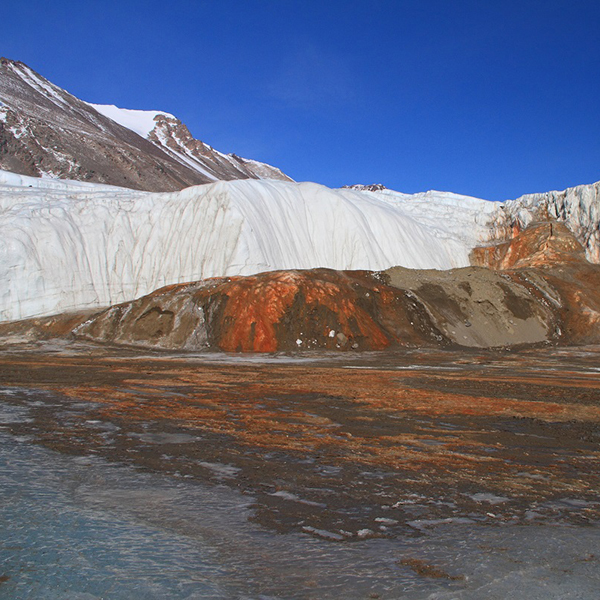Jessica Badgeley ’15, who graduated from Colorado College magna cum laude as a geology major and math minor, is the lead author of a study published in the Journal of Glaciology that solves a 100-year-old mystery surrounding Blood Falls, a red waterfall in Antarctica.
During the fall semester of her junior year at CC, Badgeley worked with University of Alaska Fairbanks glaciologist Erin Pettit and her team, seeking to understand why the waterfall sporadically would release iron-rich salty water, or brine. The brine exits the end of Taylor Glacier in East Antarctica, turning red from air contact as it descends 60 to 80 feet to the shore of a frozen lake below.
Pettit said she enlisted Badgeley to lead the study while she was still an undergraduate student to help with the overall mission of understanding the hydrological “plumbing” of cold-based glaciers. “Jessica’s work is a perfect example of the high level of work undergraduate students can do when you give them a challenge and set the expectations high,” says Pettit.
Badgeley was named a Goldwater Scholar her junior year at CC and currently is a graduate student at the University of Washington in the Department of Earth and Space Sciences.
New evidence links Blood Falls to a large source of salty water that may have been trapped underneath Taylor Glacier for more than a million years. The study, “An englacial hydrologic system of brine within a cold glacier: Blood Falls, McMurdo Dry Valleys, Antarctica,” maps the pathway this salty water takes from underneath the glacier to where it emerges as a red waterfall flowing over the glacier ice. The pathway has been a mystery since Blood Falls was discovered in 1911 by Griffith Taylor.
“The salts in the brine made this discovery possible by amplifying contrast with the fresh glacier ice,” says Badgeley. “Now we can tackle the challenge of understanding the role of liquid water — salty or fresh — in other extremely cold glaciers or permafrost environments.”
One of the study’s exciting findings, says Badgeley, is that liquid water can persist inside extremely cold glaciers, in this case 0°F, without freezing, something that scientists previously thought was nearly impossible.
Taylor Glacier is known as a cold-based glacier, which means the core of the glacier is persistently below freezing everywhere and its bottom remains frozen to the ground. More commonly, glaciers have a significant amount of ice that is at the freezing point (32°F) and very close to melting.
Pettit says that the flow of water in a cold glacier is possible because of how water freezes. “While it sounds counterintuitive, water releases heat as it freezes, and that heat warms the surrounding colder ice,” she says. This source of heat within Taylor Glacier combines with the lower freezing temperature of salty water (brine) to make brine movement in the extremely cold ice possible. “Taylor Glacier is now the coldest known glacier to have persistently flowing water.”
The research team used a technique called radio echo sounding, or radar, to detect and image the pathway of brine within the glacier. The method uses two antennae — one to transmit electrical pulses and one to receive the signals.
“We moved the antennae around the glacier in grid-like patterns so that we could ‘see’ what was underneath us inside the ice, kind of like a bat uses echolocation to ‘see’ things around it,” said coauthor Christina Carr, who is a doctoral student at the University of Alaska Fairbanks.
The salts in the brine made the image possible because they create a large contrast to freshwater glacier ice.
The resulting image clearly shows that there is a pathway of brine feeding Blood Falls. It appears from underneath the glacier and then extends horizontally more than 300 feet to Blood Falls.
